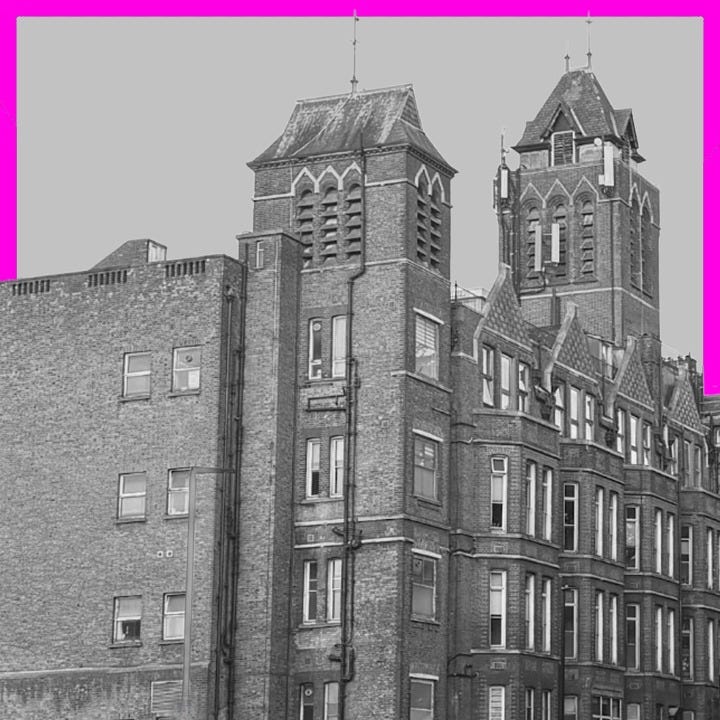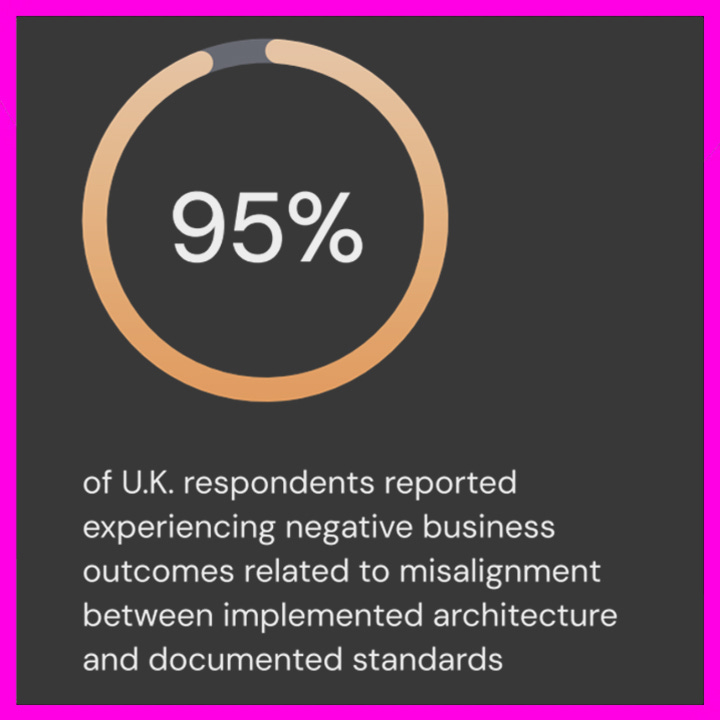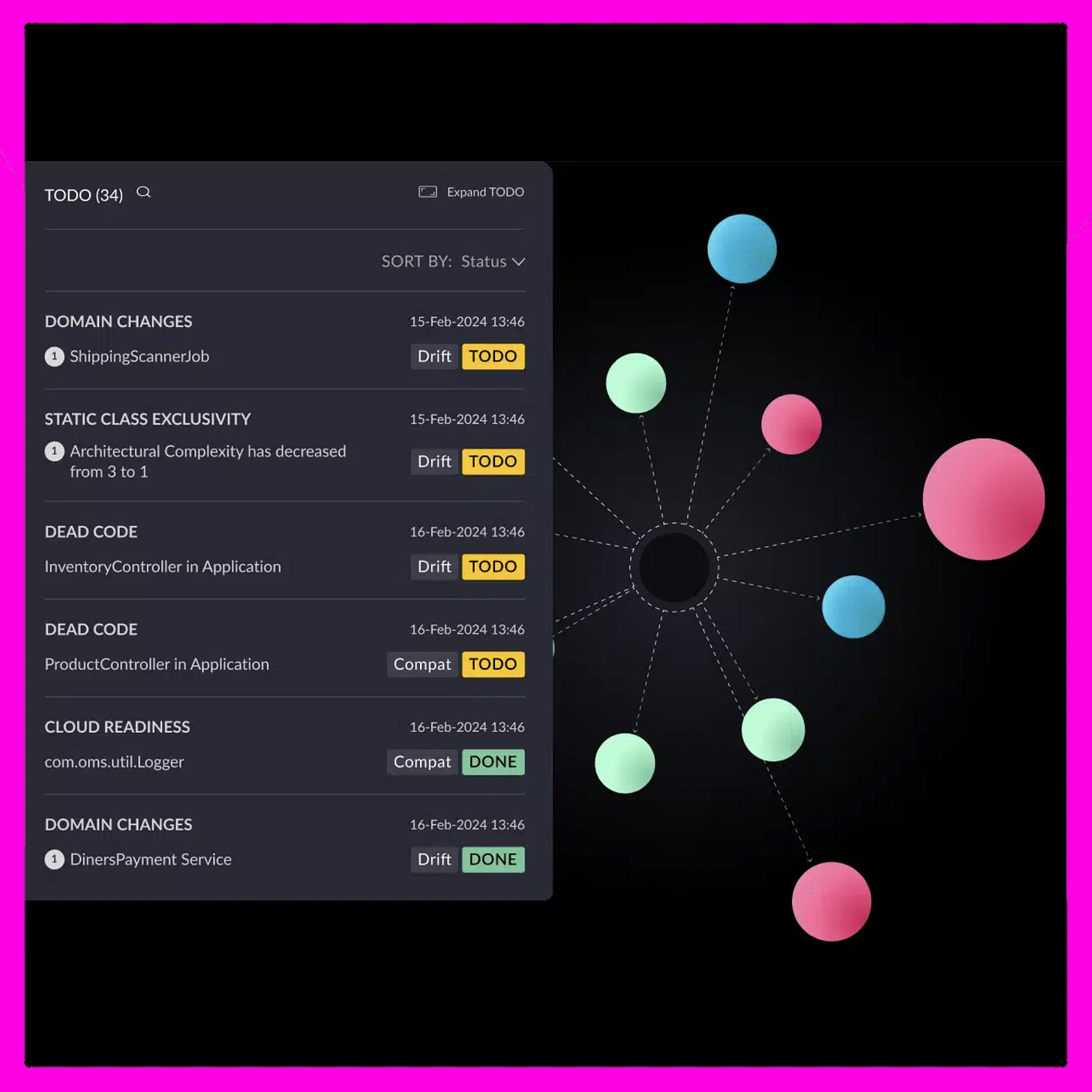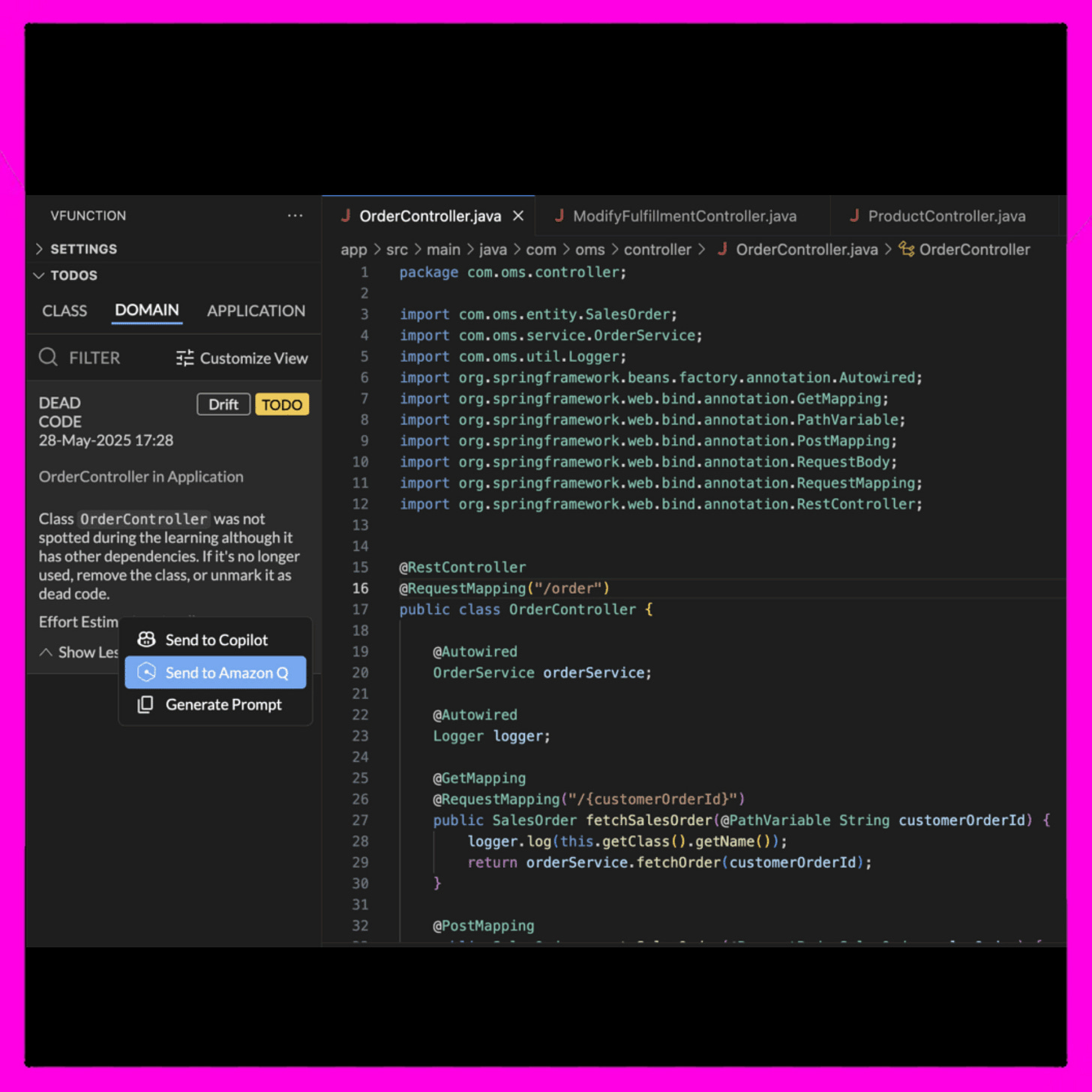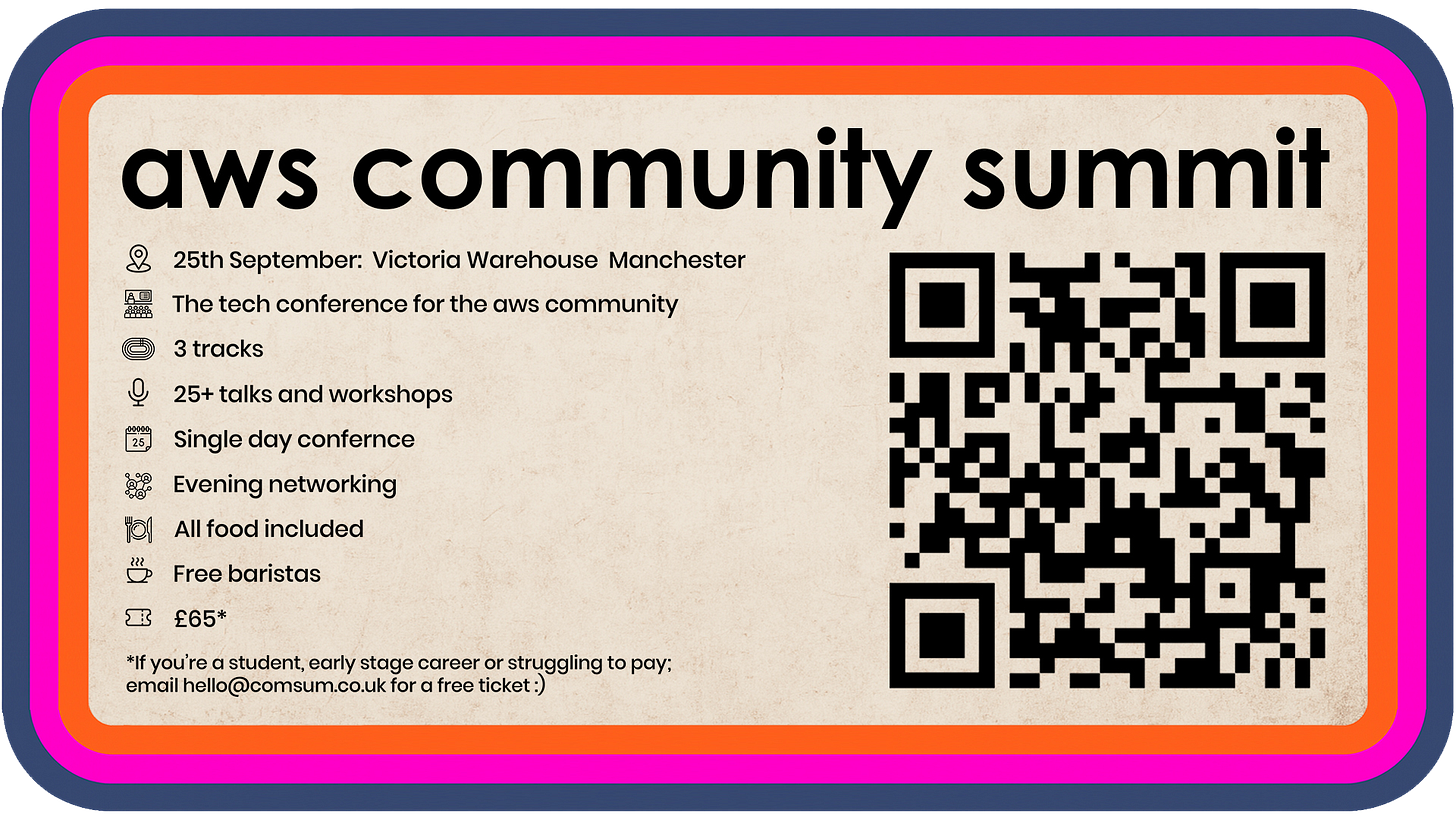Unseen Architecture, Unknown Risk: The Urgency Behind the UK's Quietly Crumbling Software
Sam Cole
Welcome to a special sponsor edition of AWSCQ
As promised last time we’ve a few issues ready to go.
Last week we had Guilherme Dalla Rosa steering the good ship AWSCQ through the deep waters of Serverless Saas; He now hands the wheel to Sam Cole who’ll be looking at modernising architecture.
Sam Cole is the Alliances Solutions Director at vFunction, leading channel and partner technical enablement, training, & delivery for the application modernization ecosystem.
Previously, Sam has worked extensively in solution architecture, consulting, and engineering roles for large datacenter and application modernization projects.
Over to you, Sam!
Introduction
I work in a beautiful old building here in the UK. From the outside, it’s charming, but look closer, and the cracks begin to show. Our software systems often tell a similar story: elegant in their early design, now quietly crumbling beneath the surface. While teams across the pond may be operating in newer, more modern environments, we’ve inherited aging systems that demand modernisation far more urgently.
Yet most organizations don’t modernize proactively. The appetite to modernise architecture rarely exists on its own. It often takes a larger trigger to spark action. For many, that trigger is cloud migration which, if it encompasses true modernisation and not just lift and shift rehosting, offers lower costs, greater agility, maximum scalability, and engineering velocity. But those gains are only possible if the underlying architecture evolves.
As GenAI accelerates code delivery, these architectural cracks are impossible to ignore.
From my experience, and in conversations with providers throughout the ecosystem, the UK is leading the region in modernisation activity. Why? Because many of our systems are older, and the hallmarks of age include outdated frameworks, buried dependencies, and languages fewer and fewer developers still know. The longer a system has been running, the more likely its documentation has drifted or vanished entirely.
Modernisation in this climate is more than a technical necessity, it’s a business imperative. And without it, these applications simply won’t succeed in the cloud. They won’t scale, adapt, or deliver the outcomes the business expects.
This article explores why modernisation in the UK is gaining momentum: from aging systems and architectural drift to the growing urgency of cloud migration done right. It draws on both data and direct experience to unpack the risks, the turning points, and the path forward.
If your organisation is confronting legacy systems or stalled cloud migrations that aren’t delivering expected outcomes, you’re not alone—and you’re not without options.
Built to last. Until it isn’t.
In my work across industries, I rarely encounter teams whose software architecture design is actually aligned with what’s running in production. Documentation gets written and forgotten. Agile delivery introduces constant change. Teams ship fast and the structure beneath quietly becomes tangled, fragile, and difficult to evolve.
vFunction’s 2025 UK Architecture in Software Development Report , based on a survey of 314 senior technology leaders across the UK, found that only 43% of organisations maintain fully aligned architectural documentation.
This lack of up-to-date records directly impacts a team’s ability to understand and resolve issues when they arise.
The architecture nobody talks about
When we talk about architecture, many still picture enterprise architecture with physical infrastructure: servers, cables, diagrams in dusty binders. But today’s software architecture is more elusive and more vital. It’s the business logic, service interactions, and code structure that hold everything together and when it drifts, everything gets harder: deployments, debugging, scaling, even understanding where an application begins and ends.
Too often, teams don’t realize just how far their systems have drifted until something breaks. Then comes the scramble: outages, security incidents, delayed timelines, spiraling costs. It’s a cycle we’ve seen play out in retail, in financial services, in manufacturing, and even in newer tech companies.
These consequences aren’t hypothetical. Our UK research found that:
39% of organisations experienced service disruptions or outages due to architectural misalignment between implemented architecture and documented standards
57% reported project timeline delays
54% faced security and compliance challenges
50% incurred higher-than-expected operational costs
48% struggled with scalability limitations
Each of these impacts was reported at significantly higher levels in the UK than in the US. When architecture is neglected, these are the real-world outcomes: systems fail, customers are affected, costs rise, and the business loses momentum.
When visibility sparks action 💡
One of the most rewarding parts of my job is witnessing the "lightbulb moment." A team uses vFunction to gain visibility into their architecture—and what they see often surprises them. It might be deeply entangled services, hidden circular dependencies, or long-abandoned flows still active in production. Sometimes they learn the system is in better shape than they feared. But more often, it’s the opposite: the teams most confident in their architecture discover the most complexity.
That’s when change begins.
Teams often experience a “lightbulb moment” when vFunction reveals the true state of their architecture, which sparks action.
With the right tooling, modernisation doesn’t have to mean throwing everything out and starting over. It means identifying what to fix, what to refactor, and what to leave alone. Done right, it’s iterative, manageable, and fast.
And again, the most effective point to begin this journey is during cloud migration, when there’s pressure to deliver something better and the opportunity to build a stronger foundation beneath the move.
Why modernisation efforts stall and how to fix them
In industries like financial services, development is often outsourced to large vendors. The internal understanding of the system diminishes over time. In retail, teams often rely on off-the-shelf software and may not even realize architectural misalignment is a risk. And in both, modernisation gets delayed until a major outage or compliance event forces the issue.
Treat migration as the catalyst for modernisation
That delay isn’t always because teams don’t care. It’s often because they lack the internal will, time, or budget to prioritize modernisation on its own. This is exactly why cloud migration presents such a critical inflection point. It creates the executive mandate, the funding, and the need to demonstrate improved outcomes, all of which make it the ideal moment to address architectural issues.
I once worked with an organisation where nobody had touched a core back-office system in years. One person had quietly maintained their "baby." Not surprisingly, they were the last to acknowledge its flaws. That’s common. When visibility is lacking, architecture becomes a personal, opaque thing. And when modernisation starts, the emotional and organisational baggage is often just as tangled as the code.
But I’m encouraged to see more organisations beginning to formalize architectural ownership in the SDLC, not just in the design phase. Some are even assigning dedicated roles like "technical debt manager" , a promising trend that shows software architecture is being treated not as a set-it-and-forget-it task, but as an evolving part of the business.
Where the data backs it up
Our 2025 UK Architecture in Software Development Report echoes much of what I see in the field:
95% of UK tech leaders report negative outcomes tied to architectural misalignment.
57% of executives believe their documentation is fully updated; only 28% of practitioners agree.
Software and hardware companies are leading the way, with nearly 70% reporting full integration of architecture throughout development—well ahead of financial services (59%) and manufacturing (50%).
And yet, the UK is optimistic. From our survey, we see teams here are more likely than those in the US to believe AI will simplify architecture, not complicate it. They’re leading in OpenTelemetry adoption. And they’re treating modernisation as a top priority, not just a side project.
Beyond code generation: How GenAI is accelerating modernisation
At vFunction, our platform combines architectural observability and data science with GenAI to make modernisation faster, more reliable, and practical for complex systems. By analyzing applications and identifying architectural issues like unneeded dependencies, dead code, god classes, and tightly coupled domains, we generate targeted architectural prompts for code assistants like Amazon Q Developer. These prompts guide developers through refactoring tasks that would otherwise take weeks to scope and plan.
vFunction provides architectural context to Amazon Q, helping teams modernize complex apps faster and maximize AWS investments.
Unlike traditional code assistants that lack architectural context, vFunction provides a system-wide, runtime-based architectural view. This is especially critical in brownfield applications, where years of change have created deeply interconnected codebases. GenAI alone can’t untangle that complexity, but with vFunction’s guidance, teams can modernise with precision and speed.
We work closely with AWS at multiple levels to support modernisation as part of migration initiatives. From cloud migration funding programs to deep platform integrations with services like Amazon Q Developer, these partnerships help customers modernise faster, reduce risk, and get more value from their AWS investments.
My advice: Don’t wait for the outage
If there’s one takeaway I want to leave with readers, it’s this: You don’t have to wait for a crisis to modernise. Start by getting visibility. Strip back the layers, see what’s really running, and let that guide your plan.
Modernisation isn’t a massive rewrite. It’s a series of smart, informed decisions that move you closer to a resilient, scalable system. And the best time to start that journey is when you’re moving to the cloud. That’s when the need is clear, the opportunity is real, and the outcomes are measurable.
Modernisation is happening in the UK. I see it every week. The organisations that succeed are the ones who stop guessing, start observing, and treat architecture not as an artifact—but as an active part of how they deliver software.
And that’s all from Sam.
A huge thanks to him for putting this one together.
You can visit vFunction at this months AWS Community Summit.
Either drop by their stand in the sponsor hall or check out their talk ‘Lifeline: Modernising The Architecture of Your Most Critical Apps’ on the sponsor stage.
Speaking of which - as you made it to the end of another edition, treat yourself to a discounted comsum ticket!
Use the code ‘AWSCQ’ for £15 off when you checkout.
If you’ve never been to Comsum, now is the time to jump on board and meet our brilliant community in person.
We love getting everyone together every year and hope that you’ll join us for what is shaping up to be our best event yet (Check out the sessions on offer here!)
It really is the most welcoming tech conference you could imagine!
Hope to see you in Manchester!
The Comsum Team.
Absolutely finally - before you go be sure to give our sponsors a click!
AWS Community Summit Events and AWSCQ are only possible with their generous support.
Let the clicking BEGIN!



